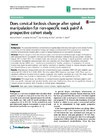Does cervical lordosis change after spinal manipulation for non-specific neck pain? A prospective cohort study

Abstract
Background: The association between cervical lordosis (sagittal alignment) and neck pain is controversial. Further, it is unclear whether spinal manipulative therapy can change cervical lordosis. This study aimed to determine whether cervical lordosis changes after a course of spinal manipulation for non-specific neck pain.
Methods: Posterior tangents of C2 and C6 were drawn on the lateral cervical fluoroscopic images of 29 patients with subacute/chronic non-specific neck pain and 30 healthy volunteers matched for age and gender, recruited August 2011 to April 2013. The resultant angle was measured using ‘Image J’ digital geometric software. The intra-observer repeatability (measurement error and reliability) and intra-subject repeatability (minimum detectable change (MDC) over 4 weeks) were determined in healthy volunteers. A comparison of cervical lordosis was made between patients and healthy volunteers at baseline. Change in lordosis between baseline and 4-week follow-up was determined in patients receiving spinal manipulation.
Results: Intra-observer measurement error for cervical lordosis was acceptable (SEM 3.6°) and reliability was substantial ICC 0.98, 95 % CI 0.962–0991). The intra-subject MDC however, was large (13.5°). There was no significant difference between lordotic angles in patients and healthy volunteers (p = 0.16). The mean cervical lordotic increase over 4 weeks in patients was 2.1° (9.2) which was not significant (p = 0.12).
Conclusions: This study found no difference in cervical lordosis (sagittal alignment) between patients with mild non-specific neck pain and matched healthy volunteers. Furthermore, there was no significant change in cervical lordosis in patients after 4 weeks of cervical spinal manipulation.
Collections
Date
2015Author
Shilton, Michael
Branney, Jonathan
Penning de Vries, Bas
Breen, Alan